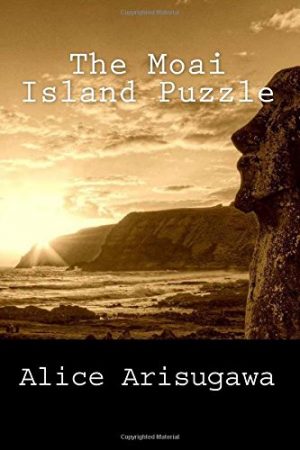
The Moai Island Puzzle is a mystery that plays on that relationship between Golden Age novels and puzzles, and follows the traditional rules much like other stories from Japan’s honkaku (orthodox) school of mystery writing. Much like the honkaku authors Soji Shimada and Yukito Ayatsuji, Arisugawa’s work wears its influences on its sleeve, to the point of being pastiche. Lovers of Golden Age will find a lot to love in The Moai Island Puzzle, and Arisugawa knows this well, and plays it.
The Moai Island Puzzle is in fact a series of puzzles. A group of university students from the Eito University Mystery Club travel to Kashikijima, a secluded island paradise, hoping to investigate a mystery left behind by the grandfather of one of their members, Maria Arima. A series of Moai statues, modelled after those on Easter Island, have been placed on the island by Maria’s grandfather to provide the answer to the location of his stash of diamonds. One summer several members of the club travel to the island hoping to find the secret. But unfortunately the secret has a dark past – the last person who came close to finding it out was found dead on the island’s idyllic shores the next day, in what appears to be a case of murder.
The group summering on the island is varied. Along with the university mystery club, led by narrator Alice (sharing the author’s penname; both are male) there is an odd assortment of characters who usually spend their summers in the island’s two villas. Other than Maria and Alice most have regular Japanese names. The pair are a variation on the old Holmes and Watson team – a duo as popular in Japan as anywhere else in the world. Arisugawa’s work is experiencing a boom in Japan following the release of a TV series based on his novels, featuring the titular Alice as a kind of bumbling, Beatles-hairstyled detective.
As the pair get closer to finding the truth behind the Moai statues the murders start to pile up. When they feel they’ve made a big step towards the secret, a typhoon descends upon the island, cutting them off from the outside world for what could be days. As the storm passes over them, the group wake to find two of their members murdered in a locked room, and the radio which provides their only contact with the outside world destroyed.
The locked-room mystery as a genre has reached the point where self-awareness has become its defining feature. Every locked-room I’ve read recently features a detective who’s tired of reading locked-room mysteries – this goes right back to Maj Sjöwall and Per Wahlöö’s The Locked Room – the eighth in their Martin Beck series. In Adrian McKinty’s Rain Dogs, the detective himself is tired of locked-room mysteries! Such self-awareness can be a burden, when not coupled with an original mystery. Thankfully The Moai Island Puzzle is original, despite how blatantly it utilises the Golden Age mystery formula. It also features a varied plot, proving that this style of storytelling is still well and truly alive.
Locked Room International
Print/Kindle
£6.89
CFL Rating: 4 Stars